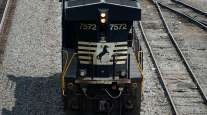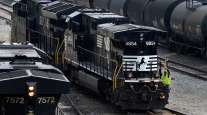Springfield News-Sun (Ohio)
Declining Coal Use Pressures Railroads
Pressures facing American railroad companies have led Norfolk Southern Corp. to engage in an “ongoing drive to enhance operating efficiencies,” raising questions about the future of its Moraine, Ohio, rail yard.
Norfolk Southern has consolidated two divisions, it announced last week. The company also said it was idling parts of its “West Virginia Secondary,” a 253-mile line between Columbus and central West Virginia. The line has experienced “steady declines” in business in recent years, the company said.
The company announced last month that it will consolidate its coal docks on Lake Erie.
Neither of those announcements mentioned the company’s Moraine terminal. Company spokesman Dave Pidgeon on Jan. 19 would not directly answer a question about whether the local operation could be closed, citing the company’s plan to report fourth-quarter 2015 earnings Jan. 27.
But Pidgeon acknowledged that Norfolk Southern is examining its operations with an eye toward improved efficiency.
The Moraine terminal has 28 employees. Norfolk Southern has said it has 2,200 miles of track and employs more than 3,700 people in Ohio.
“I can’t speak today to any specific plans for the Moraine terminal, but I can tell you that Norfolk Southern is constantly assessing how it can improve its operations, and part of that review is to examine existing infrastructure,” Pidgeon wrote in an e-mail.
The American railroad industry as a whole faces serious challenges. Yard traffic has weakened as volumes of coal shipments have dropped over the past five years, Norfolk Southern has said. In its third-quarter 2015 report, the publicly traded company said coal revenues were $482 million, down 23% compared with the third quarter of 2014.
Overall, Norfolk Southern said railway operating revenues declined 10% to $2.7 billion in the third quarter due to cuts in fuel-surcharge revenues and “continued reductions in coal shipments.”
Federal limits on carbon emissions are cutting the use of coal nationwide. The U.S. Energy Information Administration last week estimated that U.S. coal production declined by 109 million short tons, or 11%, in 2015, the largest decline ever recorded. And the agency is predicting a continued decline over the next two years.
“Weaknesses in energy and manufacturing, as well as world economic softening, had a negative impact on both carload and intermodal traffic in 2015,” John Gray, senior vice president of policy and economics for the Association of American Railroads, said in a statement.
“Railroads can’t do much about the macroeconomic environment, but what they have done and are doing is making sure they operate safely and efficiently to maximize their customers’ opportunities to grow their own business.”
It wasn’t immediately clear what impact the closure of Norfolk Southern’s yard could have on local manufacturers and shippers, including the Fuyao Glass America Inc. plant, which is located close to parts of the rail yard off Springboro Pike.
Fuyao doesn’t use the terminal, but a Moraine city official thinks the company likes knowing the yard is there.
“I think it would take away an option,” said Mike Davis, development director for the city of Moraine. “We wouldn’t want to see it [a closure of the yard].”
The Fuyao plant handles shipping without rail, Davis said, which Dave Burrows, Fuyao vice president of facilities, confirmed.
“Right now, we are not using rail, so the immediate answer is that it would not affect us today,” Burrows wrote in an e-mail.
If the yard were closed, Fuyao still could deliver on one of its eight rail spurs or secondary tracks, Burrows added.
Fuyao bought most of its plant in the spring of 2014 and slowly has ramped up glass production, recently beginning shipments of auto glass to automakers and aftermarket customers.
Fuyao Chairman Cao DeWang, has said that when the plant is fully operational it will be the world’s largest auto-glass manufacturing factory.




